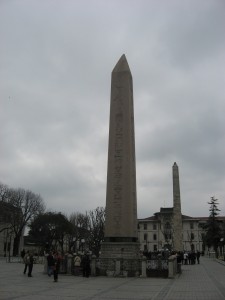Dear Commons Community,
Elaine and I spent the day touring the old city of Istanbul. The highlights were the Hagia Sophia , the Obelisk in Sultanahmet Square and the Cistern.
The Hagia Sophia was constructed during the period of 527-565 AD, under the order of Emperor Justinian. It is mentioned in the historical resources that during its construction period, the two prominent architects each had 100 architects working under them, who in turn had 100 workers each working under them.
It was used as a church for 916 years but, following the conquest of Istanbul by Fatih Sultan Mehmed, the Hagia Sophia was converted into mosque. Afterwards, it was used as a mosque for 482 years. Under the order of Atatürk and the decision of the Council of Ministers, Hagia Sophia was converted into a museum in 1935.
This obelisk was built during the reign of Pharaoh Tutmosis III (1500-1400 BC) and brought to its present site in Istanbul’s Sultanahmet Square in the late 4th century AD by Emperor Theodosius. I have always wondered at the Western World’s fascination with obelisks. We find them over and over again in main squares in capital cities such as London, Paris, St. Petersburg, Washington D.C. (Washington Monument) and in St. Peters Square in Vatican City.
The Cistern is a cathedral-size underground chamber approximately 138 metres (453 ft) by 64.6 metres (212 ft) – about 9,800 square metres (105,000 sq ft) in area – capable of holding 80,000 cubic metres (2,800,000 cu ft) of water. The ceiling is supported by a forest of 336 marble columns, each 9 metres (30 ft) high, arranged in 12 rows of 28 columns each spaced 4.9 metres (16 ft) apart. It was built by Emperor Justinian in the 6th century AD.
Tomorrow we are off to Cappadoccia.
Tony





